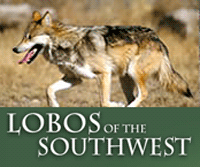Arizona Daily Star (Original) Posted on May 26, 2020 by Henry Brean
The remains of the dead cow were found early last year in the bottom of a canyon on National Forest land near Reserve, New Mexico.
All that was left was a wadded scrap of dried hide that investigators photographed then collected from the rocky ground at the base of a pinyon pine tree.
They had to soak the skin for weeks before it was soft enough for them to find tooth marks on it.
The size of the bite and the location of the hide was all the confirmation they needed. As far as the federal government was concerned, this 4-year-old cow was killed by a Mexican gray wolf.
Advocates for the endangered predator aren’t convinced.
An ongoing analysis by the environmental group Western Watersheds Project is raising questions about these livestock depredation investigations, which are being used to compensate ranchers and target "problem" wolves in Arizona and New Mexico.
The group documented significant oddities, errors or conflicting details in more than two-thirds of the 117 investigations it reviewed from 2019.
Greta Anderson, Tucson-based deputy director of the group, said she found numerous “confirmed” cases of wolves preying on cattle based on “clear logical leaps” and a stunning lack of evidence.
She said wolves may be paying for such inaccuracies with their lives.
In March alone, government hunters killed four wolves in New Mexico under federal “removal orders” that cited repeated attacks on livestock in the area.
“We want to make sure if wolves are being blamed that it’s true,” Anderson said. “We have a lot of questions. We don’t have a bunch of conclusions.”
BACK FROM THE BRINK BUT STILL ENDANGERED
The Mexican gray wolf was once common throughout portions of the southwestern United States and Mexico, but by the 1970s it had been hunted, trapped and poisoned to near-extinction.
In 1998, state and federal wildlife managers began reintroducing the subspecies to the wild with the experimental release of 11 captive-bred wolves in Eastern Arizona and Western New Mexico.
There are now at least 163 of the endangered animals roaming the two states, according to the latest population count completed in January. That’s an increase of 24% over the previous year.
But the wolf’s future remains very much in doubt. Despite recent gains, the population still faces a “genetic crisis” caused by its low numbers and inbreeding.
“This is one of the most imperiled species in the country,” said Cyndi Tuell, Arizona and New Mexico director for Western Watersheds Project. “Everytime they take a wolf out of the wild and kill it, they reduce those genetics even more.”
The Mexican wolf recovery program is a cooperative effort by nine federal, state and tribal agencies. The U.S. Fish and Wildlife Service leads the interagency team.
The Wildlife Services branch of the U.S. Department of Agriculture investigates livestock deaths and removes wolves when necessary.
Wildlife Services declined a request to interview its director in New Mexico, Robert Gosnell.
In an email response to questions, agency spokeswoman Tanya Espinosa said Wildlife Services tries to conduct its investigation within 24 hours of being notified of a livestock loss.
In addition to identifying “the wildlife species responsible for specific damage,” agency employees “provide advice, recommendations, information, or materials for use in managing problems associated with wildlife damage,” Espinosa said.
Wildlife Services received funding this year to hire “nonlethal conflict prevention specialists,” she said, and “part of that work will be focused on areas with Mexican gray wolf conflicts.”
ATTACKS ON CATTLE SPIKE, PROMPTING MORE "REMOVALS"
Brady McGee is Mexican wolf recovery coordinator for the Fish and Wildlife Service, a job he’s held since October 2018. When a decision is made to catch or kill a wolf, he is the one who signs the order.
“Ultimately, it’s my decision,” McGee said. “Wolf removal is a last resort.”
He said a number of factors go into it, including the animal’s genetic contribution to the population at large. But he conceded that the “basis of the removal orders are livestock depredations.”
Some wolves are killed. Others are captured alive — usually in leg traps or with tranquilizer darts fired from a helicopter — so they can be kept in captivity or moved to other parts of the massive experimental release area.
Relocating wolves can be a juggling act, since so much of the release area is open to grazing during at least some part of the year.
“In New Mexico, livestock are grazing on the Gila National Forest year round,” smack in the middle of some of the best Mexican gray wolf habitat there is, McGee said.
“New Mexico is the only state in the country where there are wolves overlapping with livestock year round,” he said. “We try to find a balance and alleviate the impact on the livestock industry as much as possible.”
According to McGee, there were 100 cases of wolves killing livestock along the Arizona-New Mexico border in 2018. Last year, that number jumped to 193, including 124 in New Mexico.
“Right now we’re on an equivalent pace,” he said. “March and April have been a hard time.”
March especially saw a “spike in depredations,” mostly in New Mexico, McGee said.
Much of the recent damage has been blamed on the Prieto pack, a group that once included one alpha male, one alpha female and four or five juvenile “helpers.”
After a string of livestock attacks last year, McGee ordered the removal of several of the helpers. When the problem persisted, he sanctioned the killing of the alpha male and one additional helper.
“We’ve been working this pack for a couple of years,” he said. “The ranch in that area is experiencing a lot of hardship.”
A SEARCH FOR PATTERNS TURNS UP HOLES
Western Watersheds’ position on such removals is clear.
“We don’t believe wolves should be killed for being wolves. We don’t believe any predator should be killed for preying on prey in their public lands habitat,” Anderson said. “It’s really the livestock operators that are the problem for wolves, not the other way around.”
So far, the Idaho-based environmental group has received almost 2,600 pages of federal investigation reports through a Freedom of Information Act request filed last year.
Tuell said they didn’t set out to poke holes in the investigations. The original purpose of their public records request was to analyze livestock losses in search of patterns, problem areas and possible solutions to prevent future conflicts.
“We were intent on figuring out how this was happening,” she said.
They also hoped to use location data for specific packs to independently evaluate the management decisions being made by the wolf's federal caretakers.
But the records contained too many unknowns for such detailed analysis, Tuell said. Citing privacy and other concerns, the government redacted key details in the documents, including the names of the individual investigators and the ranchers involved.
Officials also blacked out the exact locations where the dead animals were found and other details that could be used to identify specific livestock operations.
Despite the redactions, Tuell and Anderson managed to identify some patterns in the documents. The same key phrases showed up over and over, suggesting the work of a single person or the use of a shared template. In a handful of reports, the investigating officer described finding “an extensive fight scene” and noted that other cows in the area seemed “nervous.”
“I have questions about a lot of these,” Anderson said.
ADVOCATES QUESTION INCONSISTENCIES, WORRY ABOUT BIAS
In one case, a single bone from a calf and the dried husk of cow that had been dead for as much as a year were chalked up as two confirmed wolf kills. In another, wolves were blamed even though the week-old carcass was too badly decomposed to find bite marks.
Anderson said the records contain a host of similar livestock deaths that were all ruled as “confirmed” based almost entirely on telemetry data showing collared wolves in the general vicinity.
Advocates also spotted regional disparities in the records.
Anderson said wolves are “pretty evenly distributed” in Arizona and New Mexico. So why are there so many more confirmed cases of wolves killing livestock in New Mexico, particularly in Catron County, a hotbed of opposition to wolf recovery efforts?
One possible explanation is that local politics is influencing investigations. Anderson said blaming wolves for every livestock loss is a way to sabotage the overall recovery effort by convincing policy makers that the program is hurting rural residents.
To that end, Anderson and Tuell flagged investigations conducted by local authorities during the federal government shutdown in January 2019.
Anderson said there seemed to be a surge in livestock attacks at that time, and a lot of those confirmed wolf kills occurred in Catron County.
Though those reports reportedly underwent “peer review” by Wildlife Services after the fact, Anderson said she worries that the findings may have been skewed since “the government wasn’t able to investigate these things in real time.”
Catron County conducts its own depredation investigations using a dedicated investigator employed by the sheriff’s office — the only county in New Mexico or Arizona that does so.
County officials have taken a hard-line stance against wolf reintroduction, passing a series of emergency ordinances that broadly define what a “problem predator” is and allow sheriff’s deputies to kill wolves that pose an imminent threat to people.
The rural county even drafted a special “predator-human interactions complaint form” to document cases in which “the behavior of a predator has a direct physical or mental effect upon a human.”
RANCHERS CAN SEEK COMPENSATION FOR LIVESTOCK LOST TO WOLVES
It could be that wolves get blamed for more problems in Catron County because people there don’t want the predators around, or it could be that people don’t want the predators around because they cause more problems there than they do anywhere else.
McGee said the majority of the wolves living in New Mexico can be found in Catron County, though that might not entirely explain why so many of the attacks on livestock seem to happen there. He said there are “depredation hot spots” in some areas, while in others wolf packs and livestock roam the same land throughout the year with little to no conflicts.
“We haven’t figured that out yet,” he said.
Ranch owners never like to lose their livestock, of course, but some forms of depredation are better than others.
McGee said there is a federal grant program, established in 2009, that specifically covers wolf damage to cows, sheep, goats, pigs, horses and even working dogs. The livestock depredation reports prepared by Wildlife Services are often submitted as proof when ranchers apply for reimbursement.
McGee said ranchers are eligible to receive full, fair market value for animals lost in confirmed wolf attacks. They only get back half of an animal’s value in the case of “a probable wolf kill,” he said.
Advocates worry that such a system creates a financial incentive for livestock operators to blame wolves for every attack, while unfairly compensating ranchers who don’t do enough to avoid conflicts with predators, especially on public land.
Tuell said ranching operations like that are “setting the wolves up for failure.”
Of course, even the best management practices can’t completely eliminate livestock losses. Wolves will still kill from time to time. “It happens, certainly,” Anderson said.
That’s why thorough investigations are so important, she said. It’s the only way to identify real, ongoing conflicts with livestock operators and ensure that wolf packs are not being unfairly blamed — and punished — for attacks by other predators, including coyotes, feral dogs, bears and mountain lions.
Federal officials involved in the wolf recovery effort should want that, too, Anderson said.
“For a program that is struggling, with political pressure from both directions, we need to have really clear answers,” she said. “We have more questions than answers.”
Contact reporter Henry Brean at This email address is being protected from spambots. You need JavaScript enabled to view it. or 520-573 4283. On Twitter: @RefriedBrean





